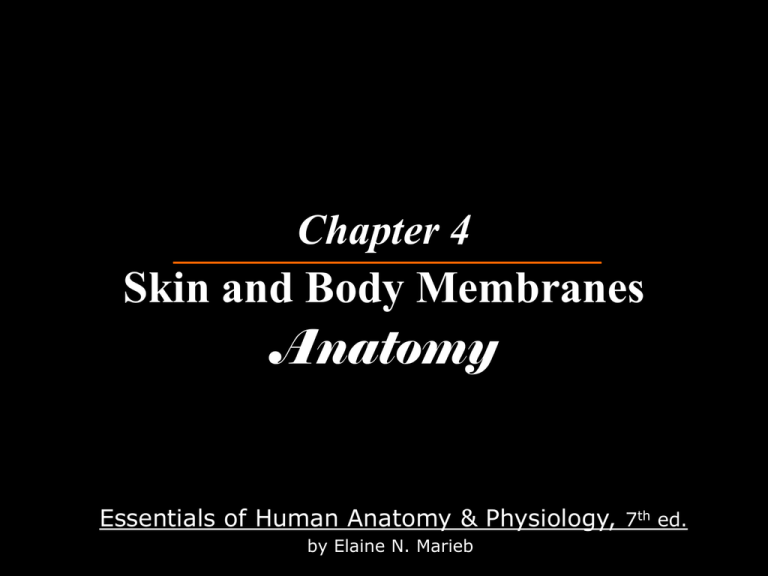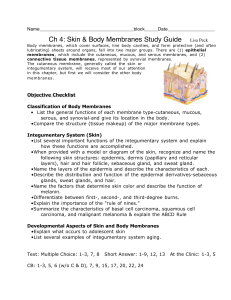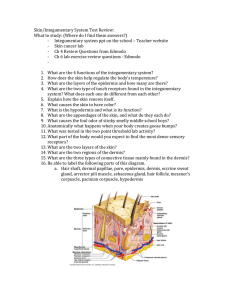Skin derivatives
advertisement

Chapter 4 Skin and Body Membranes Anatomy Essentials of Human Anatomy & Physiology, 7th ed. by Elaine N. Marieb Skin and Body Membranes: Integumentary System, Anatomy Skin = cutaneous membrane = integument = epidermis + dermis Integumentary System = Skin + skin derivatives Skin derivatives Sweat glands Oil glands Hairs Nails Skin = Integument • Covers 15-20 ft.2 • Weighs ~ 9 lbs. • Every square inch contains ~ 15 feet of blood vessels, 12 feet of nerves, 650 sweat glands, 100 oil glands, 1500 sensory receptors, over 3 million cells. • Entire epidermis regenerates every 25-45 days! Skin and Body Membranes: Integument Epidermis – outer layer Stratified squamous epithelium Avascular Often keratinized (hardened by keratin) • Dermis Dense irregular connective tissue Skin and Body Membranes: Integument Deep to dermis is the hypodermis Not part of the skin Anchors skin to underlying organs Composed mostly of adipose tissue Skin and Body Membranes: Integumentary System, Anatomy Figure 4.4 Layers of Epidermis Skin and Body Membranes: Layers of Epidermis Stratum basale (deepest layer) • Cells undergoing mitosis • Lies next to dermis • Contains two cell types: keratinocytes & melanocytes Stratum spinosum (spiny layer) • Keratinocytes mature, filling cells with keratin protein • Phagocytic white blood cells – Langerhans cells Stratum granulosum (granular layer) • 3-5 rows of flattened keratinocytes (produce keratin) Skin and Body Membranes: Layers of Epidermis Stratum lucidum (clear layer) • Occurs only in thick, glaborous (hairless) skin Stratum corneum (outermost layer) • Shingle-like dead cells filled with keratin • 5-50 cell layers thick, depending upon location The stratum corneum is thickest in the soles of the feet. It’s thinnest in the eyelids. Skin and Body Membranes: Epidermis Melanin • The pigment, melanin, is produced by melanocytes in the stratum basale. • Color is yellow to brown to black • Melanocytes have cellular extensions, called dendrites that weave between the cells of the stratum basale and spinsoum. The keratinocytes absorb melanin from the dendrites, and skin is evenly colored…usually. • Amount of melanin produced depends upon genetics and exposure to sunlight Skin and Body Membranes: Integumentary System, Anatomy Figure 4.4 Dermis • Dense, irregular connective tissue • Thickness varies • Two layers: papillary & reticular Skin and Body Membranes: Dermis Papillary layer • Most superficial dermal layer • Capillaries which provide nutrients to the avascular epidermis through diffusion • Sense receptors: pain receptors (free nerve endings) & touch receptors (Meissner’s corpuscles) • Projections called dermal papillae Skin and Body Membranes: Dermis, papillary layer As the epidermis layers superficially to the dermis, the pattern of dermal papillae is amplified. Your fingerprints, handprints, and footprints are the pattern of your dermal papillae! Skin and Body Membranes: Dermis Reticular layer • Thicker than papillary layer • Blood vessels (arterioles, venules) help maintain body temperature homeostasis • Sweat and oil glands • Deep pressure receptors – Pacinian corpuscles • Connective tissue fibers: Collagen & Elastin Skin and Body Membranes: Integumentary System, Anatomy Skin and Body Membranes: Dermis, reticular layer Separation of bundles of collagen fibers form lines of cleavage in the skin. (Langer’s cleavage lines) Why do surgeons make incisions along these lines? Skin and Body Membranes: Integumentary System, Anatomy Figure 4.4 Skin and Body Membranes: Integumentary System, Anatomy Appendages of the Skin: Hair & Nails Skin and Body Membranes: Skin appendages, hair Hair • Produced by hair bulb matrix • Consists of hard keratinized epithelial cells • Melanocytes provide pigment for hair color • Composed of a root & shaft Figure 4.7c Skin and Body Membranes: Skin appendages, hair Root the part of hair enclosed in the follicle. Shaft the part of hair projecting from the surface of the scalp or skin Skin and Body Membranes: Skin appendages, hair Shaft Central medulla Cortex surrounds medulla Cuticle on outside of cortex (heavily keratinized) Figure 4.7b Skin and Body Membranes: Skin appendages, hair The shape of the hair shaft determines the macroscopic appearance of the hair. Flat shaft = curly/kinky hair Oval shaft = wavy hair Round shaft = straight hair Skin and Body Membranes: Skin appendages, hair Associated Hair Structures Hair follicle • Dermal and epidermal sheath surround hair root Arrector pili muscle • Smooth muscle that surrounds hair follicles and contracts when cold or frightened Sebaceous gland Sweat gland Skin and Body Membranes: Integumentary System, Anatomy Figure 4.4 Skin and Body Membranes: Skin appendages, nails Nails Heavily keratinized, scale-like modifications of the epidermis. Only two layers of epidermis extend beneath the nail bed: stratum basale & stratum spinosum Skin and Body Membranes: Skin appendages, nails Slide 4.22 Nail Structures Free edge Body Root of nail Nail folds -skin folds that border nail Cuticle -thick proximal nail fold Lunula –white crescent Figure 4.9








